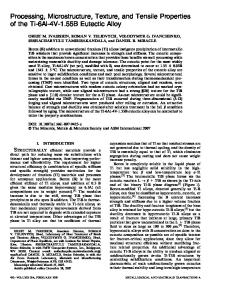Microstructure, Texture, and Tensile Properties of Ultrafine/Nano-Grained Magnesium Alloy Processed by Accumulative Back
- PDF / 2,483,065 Bytes
- 11 Pages / 593.972 x 792 pts Page_size
- 53 Downloads / 307 Views
INTRODUCTION
MAGNESIUM and its alloys exhibit poor formability and negligible hardenability at room temperature, which impede their potential application for automobile, electronic, and aerospace industries.[1] Thus, to employ their merits over many structural materials including superior specific stiffness and strength, the low-temperature hardenability and ductility of magnesium alloys should be improved. Two promising ways in this direction are the grain refinement[2,3] and manipulation of crystallographic texture.[4,5] In large-grain magnesium, basal slip facilitates microscopic yielding at very low stress. In order to accommodate further deformation, other slip systems should be activated. Koike et al.[6] showed that, in fine-grained magnesium, the dislocation cross-slip to non-basal planes occurred at very low stress level due to grain boundary compatibility stress. The substantial dislocation activity on non-basal planes brought about a respectful room temperature tensile ductility. Moreover, the low symmetry HCP crystal structure makes magnesium alloys very sensitive to crystallographic texture in such a way that their
S.M. FATEMI is with the School of Mechanical Engineering, Shahid Rajaee Teacher Training University, 136-16785, Tehran, Iran. Contact e-mail: [email protected] A. ZAREI-HANZAKI is with the Department of Metallurgical & Materials Engineering, University of Tehran, 515-14395, Tehran, Iran. J.M. CABRERA is with the Departamento de Ciencia de Materiales e Ingenierı´ a Metalu´rgica, ETSEIB, Polytecnic University of Catalonia, Av. Diagonal, 64708028, Barcelona, Spain. Manuscript submitted November 19, 2016. METALLURGICAL AND MATERIALS TRANSACTIONS A
mechanical properties vary considerably with changes in sample orientation.[7,8] Activation of different slip and twinning systems is primarily influenced by the initial orientation. For ductilizing magnesium, the initial texture should be tailored ensuring that the Schmid factor (SF) for the basal slip is maximized.[9] Severe plastic deformation (SPD) processes are considered to improve room temperature mechanical properties in magnesium alloys, e.g., References 5 and 10. During SPD, the initial grain size of the material is significantly reduced by thermally aided plastic deformation through different recrystallization mechanisms.[10,11] As deformation and grain refinement may also cause variations in crystallographic texture, the post-SPD mechanical properties result from combined effects of grain refinement and texture changes. Furthermore, it has been demonstrated that the degree of grain refinement by SPD, itself, is strongly coupled to the development of texture and substructural evolutions.[12,13] It has been proposed that grain refinement is primarily the result of the interaction of shear plane with texture and the crystal structure, followed by an influence coming from the accumulation of shear strain during severe deformation.[12] It has been known that moderate-to-strong level of complex textures can be induced during SPD of magnesium alloys.[14,15] SPD
Data Loading...











